The Meaning of Life [ii]
march 22, 2009.
Last monday, march 16th, I had planned to get on with, and maybe even finish, the editing of the 5+ hours of recordings that we made on saturday january 31st when ookoi directed the Raudio@E@rport extravaganza ![]() in the Theaterzaal
of the Amsterdam Conservatory, for the now evolving 15th edition of Raudio's mainstream.
[If you have Quicktime installed, you should be able to play the currently streaming version in a small pop-up window
by clicking the E@rport logo. Otherwise, you may click here for the pls-file ...]
in the Theaterzaal
of the Amsterdam Conservatory, for the now evolving 15th edition of Raudio's mainstream.
[If you have Quicktime installed, you should be able to play the currently streaming version in a small pop-up window
by clicking the E@rport logo. Otherwise, you may click here for the pls-file ...]
I was listening somewhere halfway through the second hour of the live stream's direct-to-disk recording when the playback on my black MacBook - in Sound Studio, my favorite one-track MacOS sound editor - suddenly stopped. I tried the usual manipulations in the case of a software freeze, but without success. Then I noticed the unusual click- and whirring sound the turning hard drive inside was making ( * ), and it dawned upon me that I had just witnessed one more bad case of sudden death ... something like a laptop's equivalent of a stroke; or like a coronary, rather ...
Oh, it had happened to me before, and those were lessons well taken; whence to me sudden laptop death no longer also means lots of hard work lost. As a matter of fact, my latest back up dates from just thirty minutes before the drive's failure, and when in a couple of weeks the machine'll be back from repair with a brand new drive, it shouldn't take me too long to bring it back to more or less the state it was in at that moment.
 It nevertheless means that a little more time than planned shall have to pass before the next substantial update of Raudio's ookoi@E@rport stream. But maybe also as a result there will
be some more 'soundblogging' than usual. For though it does not permit any audio- and video-editing of importance, the small, light, cheap´n'handy Asus netbook that I use to 'work on the road' is a most suitable tool for writing.
It nevertheless means that a little more time than planned shall have to pass before the next substantial update of Raudio's ookoi@E@rport stream. But maybe also as a result there will
be some more 'soundblogging' than usual. For though it does not permit any audio- and video-editing of importance, the small, light, cheap´n'handy Asus netbook that I use to 'work on the road' is a most suitable tool for writing.
Which brings me to another point that I would like to make, being the fact that maybe it is high time that we should stop cramming our digital work- and lifetime into one single all-purpose machine. Maybe we should get back to - and it is indeed a 'going back to' - entrusting different aspects mainly to different tools. I am pretty satisfied using my netbook, that needs relatively little computing power, rather  specifically as a portable digital writing machine, which also enables me to check through a wireless connection some facts on the web.
And though I used to be among the first to ridicule the use of cellphones for web surfing, I now think that there is hardly a better way to keep up with online news, watch the latest uTubes, and read my favorite blogs, than on the go - in metro, bus or train, or just somewhere waiting for something or someone - on my iPhone ...
specifically as a portable digital writing machine, which also enables me to check through a wireless connection some facts on the web.
And though I used to be among the first to ridicule the use of cellphones for web surfing, I now think that there is hardly a better way to keep up with online news, watch the latest uTubes, and read my favorite blogs, than on the go - in metro, bus or train, or just somewhere waiting for something or someone - on my iPhone ...
So maybe I should get myself a powerful desktop machine, and dedicate that specifically to all the voluminous digital sound and image editing work, and only use the laptop for these tasks occasionally; which might just prolong its life time, simply because it will be used far less intensively ?
[ How about that, hein, for a Har$' gadgetry and consumption rant? ![]() ]
]
The incident indeed invites for serious reflection on the "consumerism" that is inherent in the methods of work and production that I (and many others) have chosen, developed and come to rely upon over the past eight years or so.
A lot of my pretty voluminuous output in words, sound and images comes about through digital editing on the one laptop that I carry around with me from here to there and back again. Much of it finds its way via a manifold of web and internet channels, straight from the laptop's drive. On the average day of the week you will find my laptop up and running for at least 16 of the 24 hours, and during a major chunk of these 16 hours I will be sitting behind its screen writing and/or editing sounds and/or images. It is the sort of 'digital dependence' and the epheme/r-e-ality, the vulnerability of digital works exclusively stocked on a single machine, that already made me step up from one full back up of 'current + archives' to two complete back ups on distinct external drives. It also is the reason that I seriously considered getting (again) a second fully functional laptop, to fall back upon in case the first one breaks down. (Raudio in fact had a second laptop that I used as a spare machine; but that one died on me a couple of months ago: its logic board failed, which is pretty much the end of the story for a Mac laptop when it is 'hors garantie' ...)
Getting equipped with two machines so as to maximize the chances that at any given moment at least one of them will be functional, obviously is a possible line of action. Faced with deadlines and a continuously growing amount of work that has to be done maybe it may even seem a necessary one. On the other hand, isn't the reason that I do feel sort of forced to consider buying two of each of my principal digital worktools due to the fact that the reliability of the consumer electronics that we continue to be seduced into buying - also, notably, that of the the products produced by by the reputed brand manufacturer based in Cupertino, California - does not live up to the demands of the sustained and intensive use that we are encouraged to make of them? Over the past five years no less than three different Mac laptops died on me no less than five times; three out of five times the reason was a sudden, and non-recoverable, drive failure. My latest one, the black MacBook, already showed annoying buggy behavior last year, when for a while it all the time pretty much randomly shut down. That problem was, admittedly, in a most admirable manner handled by the genius at the Amsterdam Apple store, who first, within hours, replaced the heat sink; and when that did not solve a thing, instead of taking it in and sending it off for factory repair, had the inspired idea to replace the battery, which indeed did the trick ... A couple of months later there appeared the infamous 'MacBook palmrest hairline crack', a general fabrication (or, as some insinuate, a 'made in China') flaw for which I could not be bothered to demand a repair. I just covered it up with a piece of scotch...
When the drive gave up life this monday, the machine was just one week past its second birthday.
I think that is mighty young ...
Still, of course, most of the time the Macs 'do it', and when they 'do it', they're a great pleasure to use. Unfortunately they are not made so as to continue 'to do' it for what I would consider a reasonably long time. And obviously, though sadly enough, this lack of durability of consumer goods is a cornerstone of the capitalist mode of production, that concentrates not on the sustainability and continuing use of that what we have, but foremost on that what we should get (= buy) next ...
...
It is sort of ironic - in an interesting sort of way, I think - that the reason for, the source of and the input to all of this digital hi-tech busy bees-ness is actually of a diametrically opposed nature. Though, let's face it, there is a little bit of that in it as well, it is thus not primarily because of principles or because of ideologically based choices. It mainly is the way that it is as a matter of fact.
It is a matter fact that as practicing musicians and as artists, the principal materials of myself and of many of my friends and colleagues consists in old analog tapes that we either lo=fi=ly recorded onto ourselves, or that we picked up from the street, on flea markets and in garagesales; in the weird, odd, strange and/or useful (electronic and other) stuffs that people put on the pavement in and around Paris and elsewhere, that we pick up before the trash men do, in order to recycle them and put to good new use. And when we use instruments in performances, instead of hooking up a laptop, you'll rather see us strumming second hand electric guitars, or hitting some pieces of home built percussion ...
Or vintage analog electronics, of which especially FlexRex and Cosmo Helectra possess an amazing collection. They were put to great use [au sein de] Cosmodrone, a project that - after our 2005 adventures at the First European UFO Congress in Châlons-en-Champagne (France), performance at the Montreuil Machinante (that I still remember as being particularly inspired and musically interesting), a dinner concert at Mains d'Oeuvres in Saint Ouen in 2006 and the great Orguanisation composition/installation at that year's edition of Sonic Protest - for reasons partly beyond our control, was somehow put to sleep ...
 |
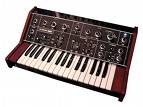 |
I was therefore really happy when some time ago I received a mail from Cosmo with an idea for a Korg-only performance. That was just around the moment that I had started thinking about how to use the date at the Montreuil La Guillotine that I had been proposed a little earlier. It was the birth of KorggroK, essentially a trio of vintage analog Korg synthesizer players: FlexRex and Cosmo play their 1976 Korg 770; I play the MS20 that almost 30 years ago in a music store in Amsterdam I acquired by swapping it against the Fender Bandmaster Reverb guitar amplifier that I had been using ever since the early days of Quirass.
...
We performed "La Fin des Temps" at La Guillotine in the rue Robespierre in Montreuil on the afternoon of sunday march 1st, using the three synths and a gong ... (Thanks to Clémentine Ader)
...
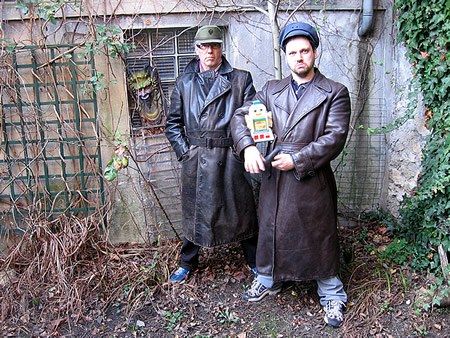
|
|
|
KorggroK's Har$ and FlexRex photographed by KorggroK's Cosmo Helectra in a Montreuil backyard during the february rehearsals for "La Fin des Temps". | |
FlexRex recorded our just over 16 minutes performance of the palindronic analo-electronic piece "La Fin des Temps" (Tne End of Times) directly from the mixing console. It sounds and feels just great: dense, crispy and quirky. For now the recording has been archived, waiting to be complemented by more KorggroK material in the hopefully not too far away future ...
Speaking of archives, on friday afternoon march 19th I attended the end presentation of the Play Out project, at the Netherlands Institute for Media-art (Montevideo/Time Based Arts) on the Keizersgracht in Amsterdam.
It was interesting.
As its name suggests, the NIMk constitutes itself as the patron of media art in the Netherlands, and as such is the keeper of a large (though still far from complete) collection of video art that has been produced in (but also outside of) the Netherlands since its emergence as of the mid 1960s. An important part of Play Out was the research into the technical means necessary for a lossless (primarily in terms of image quality) conservation of this art.
As you can imagine this is a problem; if you make it one...
Until not so very long ago, videoart was an analog art. The images were written onto magnetic tape, for which, over a period of not even thirty years a plethora of different formats were used. If you're a museum person, an archivist, a conserver, a curator, an art historian, I guess ideally you should want to be able to keep the original video tape along with a machine that can play back that tape. But this seems not to be an option that anyone even considers. The reason is probably not so much the (considerable) logistic and technical difficulties of keeping a whole zoölogy of vintage machinerie operational, as the short life span and gradual deterioration of magnetic tape, which moreover meanwhile became obsolete by itself: analogously stored video is bound to slowly disappear ... and the disappearance of the medium 'magnetic tape' itself will render it near to impossible also to continuously produce 'new' tape copies of the original. Even if that could be done virtually without loss, for example by passing via a conform digitally copy of the original tape, one would need 'freshly produced' magnetic tape of the same specifications as that used for the original piece.
In order to stay ahead of the destructive powers of time, Time Based Arts and related institutions already in the 1990s, as part of the Deltaplan Cultuurbehoud, undertook a major conservation project, in which some 900 hours of video art, created on as much as 10 different tape formats, were transfered to Betacam SP tape. That still was an analog format. And tape remains tape. It was thus that in the following decade, between 2001 and 2003, a selection of 650 from those 900 hours was transfered once again, this time onto Digital Betacam, a digital format, though different from the file formats as we know them from video on our PCs. Meanwhile technological standards continued to change and once again: tape remains tape. Hence now, some 7 years later, it is considered once more high time for a next phase of conservation. In the Play Out project the technical staff of the NIMk researched the divers options. They did a great job, and their presentations justly impressed the audience. For those interested in the specifications, these were their conclusions: best to use a Blackmagic Multibridge Pro, to convert the collection into a collection of AVI files (V210 codec), stocked on LTO tapes. Surprisingly enough, maybe, in tests tape proved still to be the best option for storage, though Wiel Seuskens did not exclude that this might change soon, as a result of the continuing progress in hard drive technology. He also estimated that one would be able to convert by these means approximately 3,5 hours of video art material per day, that the current 1000 hours collection would ask for about 100 terabyte of storage, and that the costs of storage (which includes - obviously - a double of each tape, regular data verification and eventual correction, cooling ( ** ), etc.) would amount to an estimated 350-500 euros per terabyte per year ...
And then here´s the catch: all of this said and done, given the experience of the recent past, the continuing unforeseeable technological developments and the ongoing changes in formats, it is more than likely that in the near future a such migration of the complete media art collection to ever different formats on ever changing physical carriers will continue to be necessary every 7-10 years ...
Can you picture it? Artists don´t stop producing art. There´s evermore of them (good!), and more and more of them go digital (right on!). More and more of their works will be entered into an ever expanding national bag filled with digital art, like a latex balloon, proudly inflated by national and international dat-art curators, and kept floating by a team of white coated data specialist, nurturing these data, checking them, correcting them, migrating them ... from one format on to the next one, and then to the next one.
Now that´s fascinating, ain´t it ?
More interesting, though, is the question whether one should. Is this really the way to go? I am glad that I attended this Play Out presentation, as it helped me to make up my mind: for personally I think we should not. I think we should let the originals fade and die away along with their original formats and technological context; because they are inextricably linked to that specific technology, without which they would not have been. If they are not, that is, if they are independent of their techn(olog)ical realization, they are ´conceptual´ in the way a scored musical conmposition is: a such work may be re-created, and may continue to exist through its ´interpretations´. Contemporary copies of those works that are destined to die along with the technology that once brought them into existence should be set free, maybe (depending on the wish of artist) together with some form of a creative commons license, or - if there is no such wish - simply by putting them into the public domain.
I am well aware that this is not a popular opinion. It is fundamentally opposed to for example the position of one of the partners in the Play Out project, the Stichting Behoud Moderne Kunst (Foundation for the Conservation of Modern Art), represented at the meeting by Hugo Bongers. Hugo shivered at the mere idea of ensuring the durability (at least in ´spirit´) of fundamentally transitory works of art by permitting the potentially unlimited (if not free) distribution of their digital copies, and releasing them from the protective exclusiveness of an existence as ´unique specimens´ accessible and viewable only in the closed and controlled contexts of museums and art shows.
It is a position that as a general rule is quite obviously untenable. So I wish him luck: he is fighting a battle that already was lost times ago. For if ´modernity´ taught us one lesson, it is that the idea of art - like the meaning of life - as residing in eternally existing material objects is not merely an unnecessary one. It simply is false.
Much of modern art, and specifically performance and media art, at heart is very much like music.
...
Here are some pictures made at La Guillotine in Montreuil on the afternoon of sunday march 1st, the march edition of the monthly Les Dimanches de l´Impro.
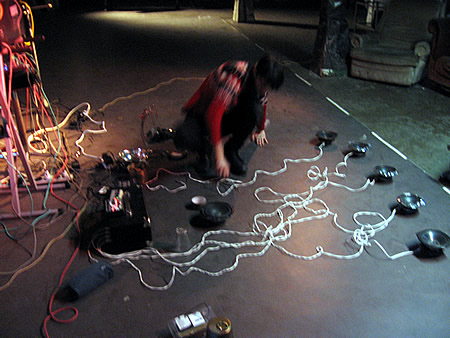 |
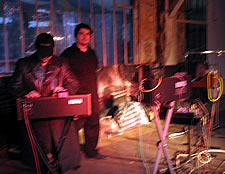 |
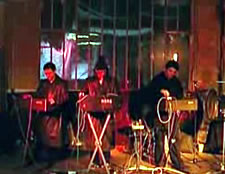 |
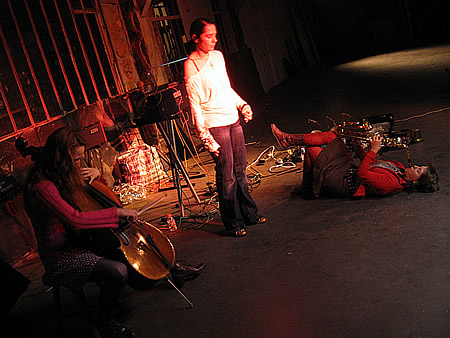 |
The event started with a performance by Francesco Cavaliere. Next there was KorggroK doing its La Fin des Temps, and it all ended with a fine free improvisation by the GHK Trio (Béatrice Godeau (cello), Cathy Heyden (alto-sax) and Judith Kan (vocals)). Clicking the images for each of the performances will lead you to a short uTube impression, as compiled and put online by Rébus.
These give you an idea of how it was.
It no longer is.
Nonetheless it continues to be.
notes __ ::
(*) You will find a great many stories of laptop hard drive crashes in blogs and in forums. That is partly inherent in the medium (as it is
the principal tool used to produce its content), but also due to the
minimality of the time buffer between content production and publication on the web, which may
virtually be nil; last but not least, writing about such un-fortune has an undeniable auto-therapeutic effect :-) ... Interesting I found the divers descriptions of the sound a crashed drive is making. "A slight clicking, like tapping your fingernail on the window," Mickey Panayiotakis said, while Rickard Andersson, suddenly heard "a rather loud grinding sound". Others speak of "buzzing", or of a strange pulsating noise, that goes like "errr..errr.....errr..errrr....." The crashed-hard-drive.com web site lets you listen to and/or download some samples of the divers sounds made by crashed drives ... [ ^ ]
(**) Though it is not directly related, at the Play Out meeting I learned a pretty astonishing fact concerning our society´s ever faster growing computation and data-bulimia. Amsterdam is a main junction in the continental data traffic, and apparently the electricity used solely by the Amsterdam based data center (much of this for cooling) on a yearly basis equals that of all the rest of the dutch capital ... [ ^ ]
tags: computer, Apple, Cosmodrone, KorggroK, Paris, Amsterdam, media art
# .299.
smub.it | del.icio.us | Digg it! | reddit | StumbleUpon
comments for The Meaning of Life [ii] ::
|
Comments are disabled |